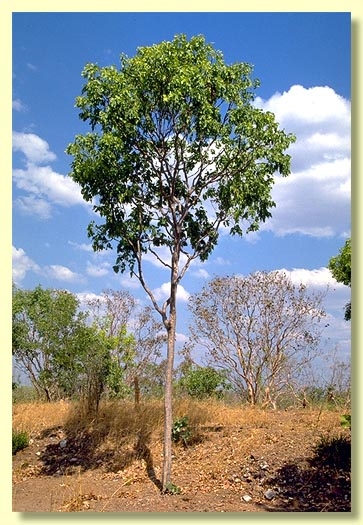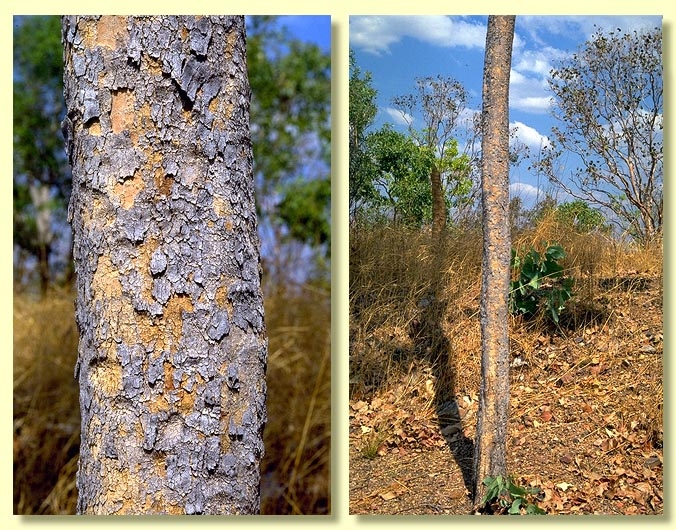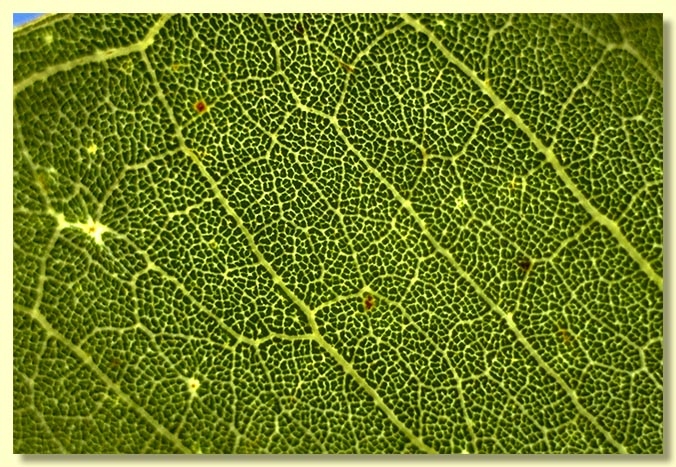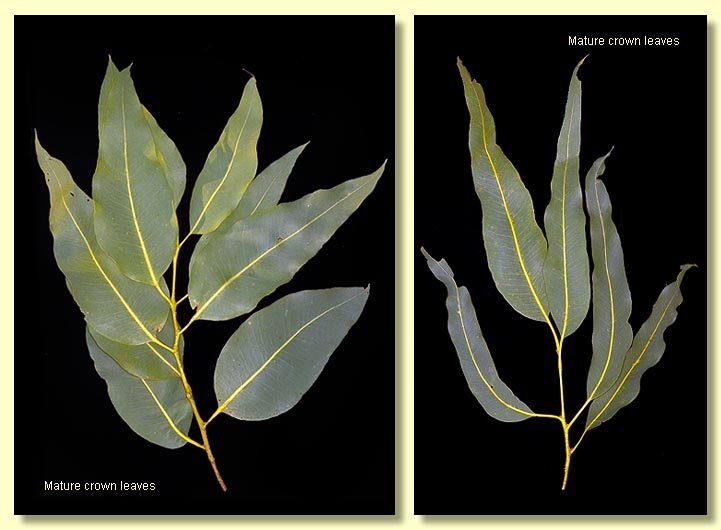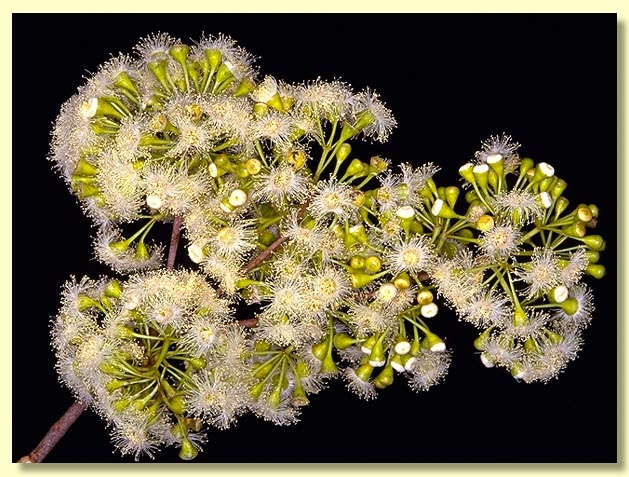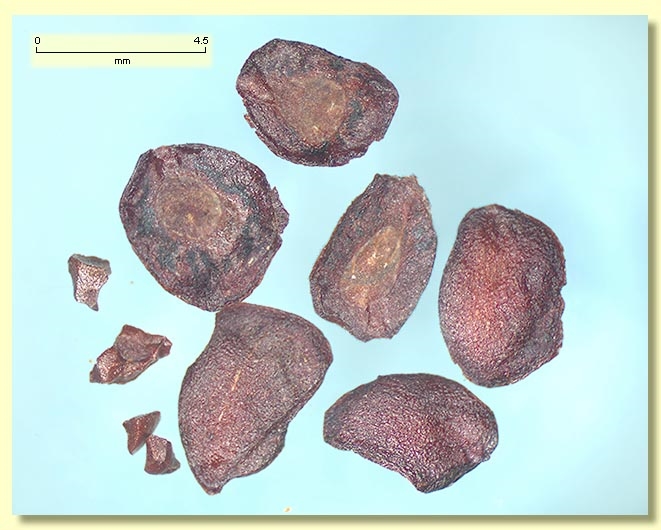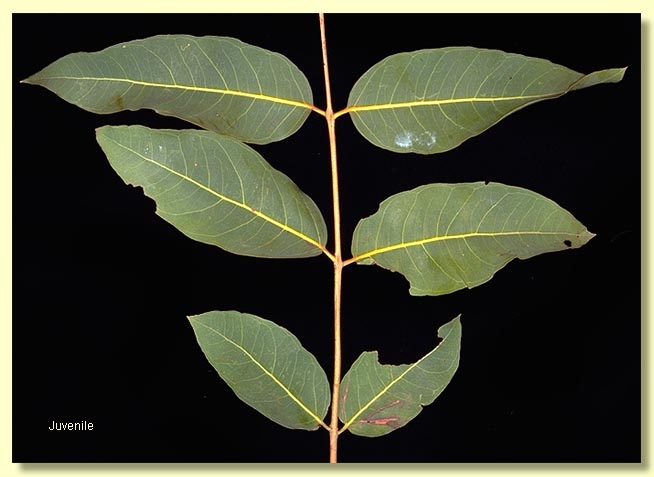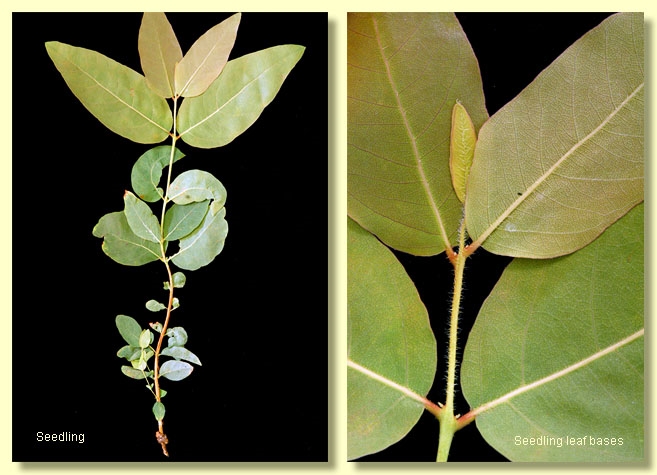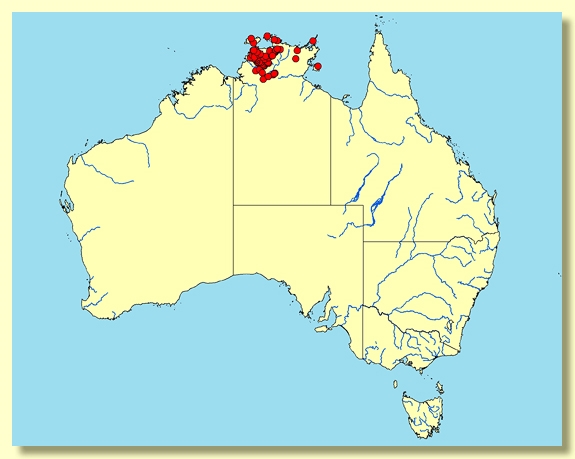Corymbia | Blakearia
Euclid - Online edition
Corymbia polysciada
Tree to 15 m tall. Forming a lignotuber. Deciduous in mid dry season.
Bark a rough stocking extending over part of or, less commonly, all of the trunk, with a clear demarcation at change to smooth bark. Rough bark dark grey, tessellated, smooth bark creamy white to pale grey shedding in thin scales, the surface sometimes powdery.
Branchlets lack oil glands in the pith; smooth.
Juvenile growth (coppice or field seedlings to 50 cm): stems rounded in cross-section, sparsely scabrid to virtually smooth; leaves opposite or a few pairs sub-opposite, petiolate, lowest leaves sub-orbicular, soon becoming cordate to ovate-elliptic then tending to lanceolate at upper nodes, 5.5–24 cm long, 3.5–14 cm wide, ± undulate, the base lobed to rounded, apex rounded to pointed, slightly blue-green to green, at best sparsely setose with the bristle-glands confined mainly to the petiole and midrib with few on the lamina.
Crown leaves opposite toalternate, petiolate, petioles 0.7–3.3 cm long; blade ovate to elliptic to broadly lanceolate, 6–21(25.5) cm long, 1–7.5(11.5) cm wide, undulate, base tapering to petiole, apex pointed, margin entire, concolorous, glossy or dull, green, smooth, side-veins at more than 45° to midrib, reticulation dense to very dense, intramarginal vein present, oil glands obscure. New growth flushed with pink-purple, rapidly turning green.
Inflorescence axillary compound, condensed, the rhachis with a short stout basal internode 0.1–0.5 cm long, and a second internode 0.3–1 cm long or sometimes absent, peduncles variable, ca 0.2–4 cm long, buds 7 per umbel, pedicels (0.8)1.2–3.2 cm long. Mature buds pyriform, 0.6–0.8 cm long, 0.4–0.7 cm wide, surface smooth and glossy, scar present (outer operculum shed during bud development), operculum rounded to flattened, stamens inflexed, all fertile, anthers oblong, dorsifixed, versatile, dehiscing by longitudinal slits, style long and straight, stigma ± tapering, locules 3, the placentae each with ovules arranged in 3 or 5 vertical rows. Flowers creamy white.
Fruit pedicellate (pedicels 0.8–3.1 cm long), cupular to cylindrical or barrel-shaped, 0.9–1.5 cm long, 0.8–1.1 cm wide, thin-walled, smooth, disc descending vertically, valves 3, enclosed.
Seeds brown, 4–6.5 mm long, flattened to saucer-shaped, dorsal surface smooth, hilum ventral.
Cultivated seedlings (measured at ca node 10): cotyledons orbicular; stems rounded in cross-section, densely setose with long bristle-glands; leaves always shortly petiolate (petioles to 0.3 cm long), opposite for at least 13 pairs, ± orbicular to ovate-lanceolate, 4.5–12 cm long, 2.3–5.5 cm wide, base rounded or tapering to petiole, apex rounded or pointed, green, discolorous, setose but only sparsely so above and below by node 13.
Flowering has been recorded in June, August, September, October and November.
A ghost gum tree widespread in the Top End of the Northern Territory from Melville Island and Cobourg Peninsula south to Mataranka and east to near Yirrkala and north of Bulman, but absent from elevated sandstone areas, preferring low stony rises and gravelly lower slopes and plains. Corymbia polysciada has a distinctly tessellated stocking of rough bark sharply demarcated from the smooth white bark of the upper trunk and branches, and a crown of petiolate, ovate-lanceolate, dull or glossy, glabrous, green to grey-green leaves. Trees are deciduous in mid-dry season but soon develop a new crowns of red-purple leaves that rapidly become green. Flower buds develop just before the new flush of leaf growth.
Within its natural range this species is distinguished from other ghost gums by the combination of distinctly tessellated stocking of rough bark on the lower trunk with smooth white bark above, glabrous crown leaves, and buds which form before the new ovate-lanceolate crown leaves develop, and the relatively long pedicels (1.2–3 cm) of the buds and fruit. Other partly rough-barked ghost gums in the area are C. confertiflora and C. disjuncta, which have setose crown leaves that are ovate-cordate. Compared with C. polysciada, C. kombolgiensis has thinner rough bark more scaly than tessellated, narrowly lanceolate crown leaves, shorter peduncles and pedicels on buds and fruits, and occupies a more elevated position on sandstone escarpments. Other ghost gum species found in this area are essentially smooth-barked (C. bella, C. arafurica, C. grandifolia).
MORE ABOUT CORYMBIA
MORE ABOUT GHOST GUMS
Corymbia polysciada: Greek poly, many and sciado, canopy.

